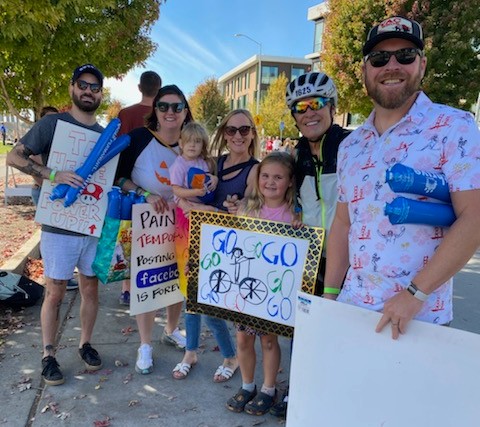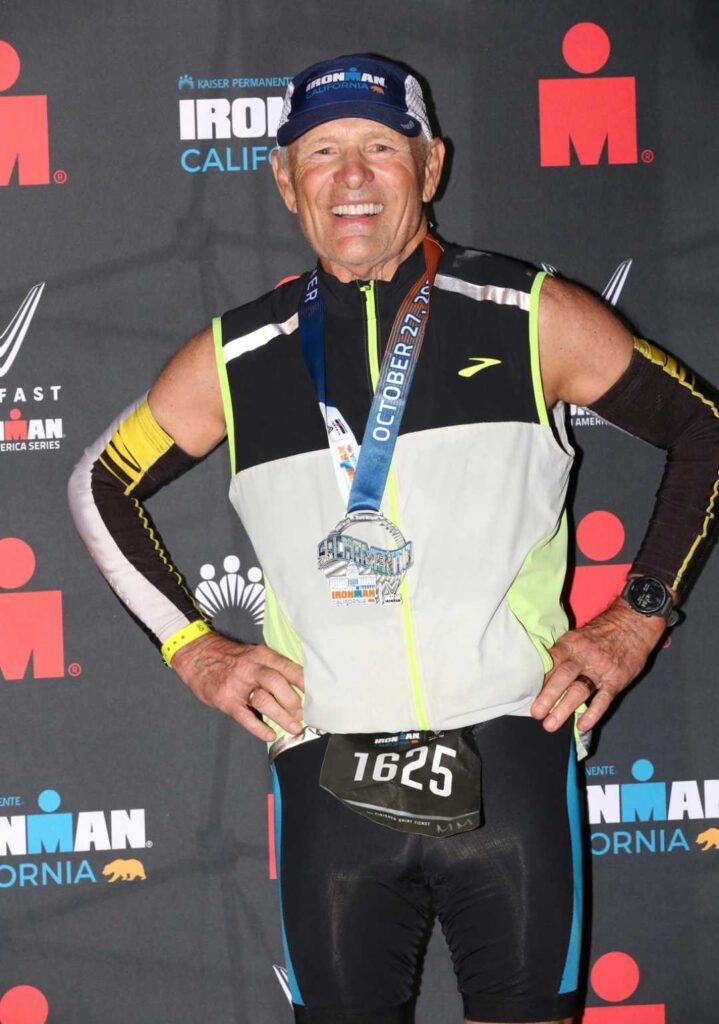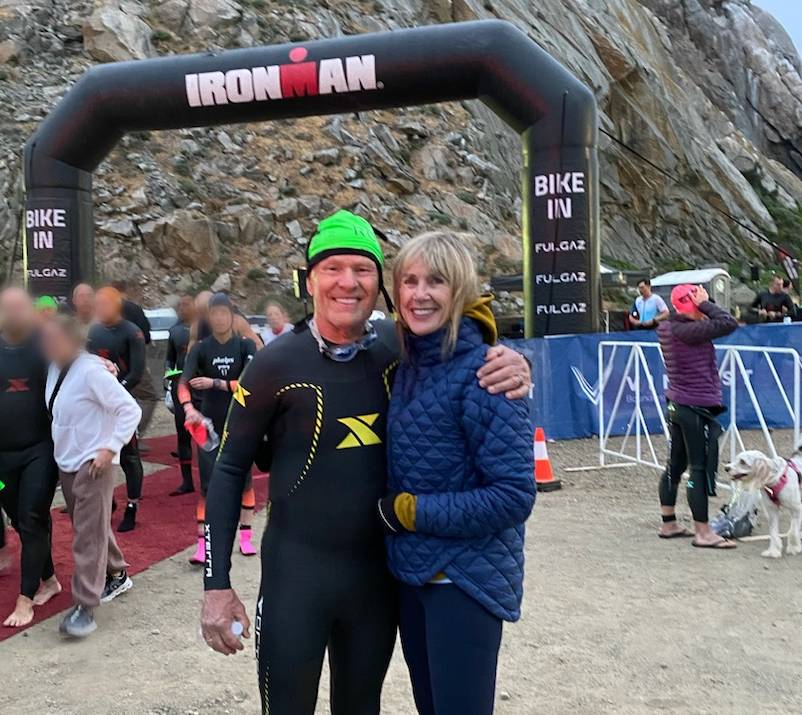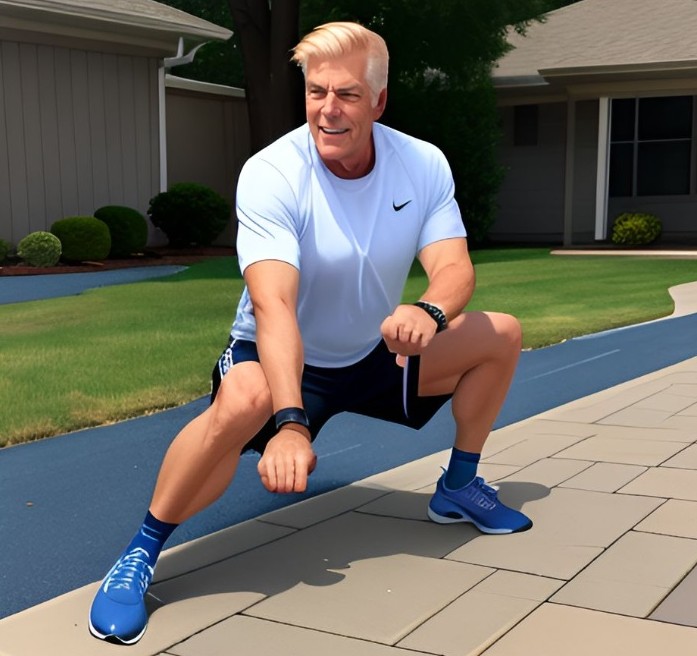How 75 Became My Best Ironman Year Yet – Rick Burgess’ Story
Caption: Rick and Elaine Burgess at the 2024 Morro Bay 70.3 swim start.
Stamina, Strength, and Wild Goals
When does getting older mean getting better? That’s the question I asked myself after completing Ironman California in late 2022. It was my fifth full-distance Ironman, and while my time of 15:45 wasn’t remarkable, crossing the finish line is always a win. Later, I realized I was the oldest finisher among the 2,600 participants. At 73, that achievement sparked a thought: If I could do this at 73, what could I accomplish at 75?
Inspired, my wife Elaine and I decided to celebrate my upcoming 75th birthday by taking on all five California Ironman races in 2024—Oceanside 70.3, Morro Bay 70.3, Santa Cruz 70.3, Ironman California 140.6, and Indian Wells 70.3. The word celebrate felt deliberate since there are no guarantees at this stage of life. Each race would honor the health and strength I’d been given while aiming to see what was possible.
Building on a Lifetime of Triathlons
I’ve been competing in triathlons for 25 years, with my first full Ironman at Panama City in 2004. I was a runner in my late 40s. When I tweaked my back one summer, my physical therapist encouraged me to swim while recovering. Over the next few months, I worked up to swimming over a mile. I thought, I can run, I have a bike, and now I can manage the swim. I should do a triathlon.
The first year (2001), I signed up for three tri’s – a Sprint (Uvas) and two Olympic (San Jose and Santa Cruz) distances – and an aquathlon, all in the Bay Area. I still remember coming out of the water in the sprint. My bike, a mountain bike, was the only one left in T1. The next year I did the same Sprint and an Olympic tri, but added two 70.3’s: Vineman-Santa Rosa and Big Kahuna-Santa Cruz. I was off!
During that time, I was a good runner and an average swimmer and cyclist, solidly middle-of-the-pack. Over time, as the field in my age group thinned, my rankings improved.
Achieving All-World Athlete Ranking
IRONMAN® ranks all athletes worldwide that complete an Ironman race, called the All World Athlete program. The top 2% in each age group earn Gold, the next 5% Silver and the next 10% Bronze. My first Bronze award came while competing in the 65-69 age group. I earned a second Bronze while competing in the 70-74 age group.
I really enjoyed the challenge of triathlons. Having finished the Boston Marathon six times, I was a comfortable and competitive runner. I found the swim/bike cross training a challenge and an important part of balancing the wear and tear of running. Plus, tri’s are fun races and I enjoy the excitement and camaraderie.
The base I had built was about to be challenged, though, as the 2024 races were sure to be an adventure. I hadn’t competed in a triathlon in 16 months and had never raced Oceanside. Morro Bay was equally unfamiliar territory. Yet, I was optimistic and ready to embrace the challenge.
Oceanside: A Strong Start
The Oceanside race was exciting and nerve-wracking. It’s known as the unofficial California Ironman championship, so I expected strong representation, even in the 75-79 age group. Eight of us started, and I ended up finishing third out of five. The harbor swim took me 48 minutes, complicated by swimming into the sun. The bike course, winding through Camp Pendleton, was challenging, with many athletes dismounting and walking up steep hills – a rarity in triathlons. Despite the hilly course, I completed the bike leg in 3:45 and finished the run in 2:25 for an overall time of 7:16. I felt pleased and confident heading into the next event.
Morro Bay: The Challenge of the Tide
Morro Bay seemed like it would be easier than Oceanside, with fewer hills and a “saltwater lake” swim. The venue was picturesque, though the water was cold at 58°F. The swim quickly turned into a battle.
A strong opposing tide made progress painfully slow and the water temperature dropped to the low 50’s. At one point, I clung to a buoy with others, unsure if I’d make it to the finish. My swim took 1:18, far exceeding my 45 minute goal. I finished, shivering and tired, failing to meet the 1:10 cutoff.
Soon afterwards, I realized many others also struggled, and race officials hadn’t strictly enforced the cutoff. I could have continued. While I regretted not finishing, safety felt like the better choice. Ironman appropriately offered free entry to another event to the 100s of entrants who DNF’d on the swim. I used it to register for Oceanside 2025 after Ironman announced that Morro Bay would no longer be held.
Finishing Strong
The remaining three races brought redemption. At Santa Cruz, I clocked a 41 minute swim and finished in 7:15, securing second place in my age group. IRONMAN California was a standout, winning my age group with a finish time of 14:45—nearly an hour better than my time two years earlier. At Indian Wells, I was the only competitor in my age group and won in a time of 7:24.
At year’s end, I achieved an unexpected accolade: Ranked #1 globally (Gold) in my age group in the Ironman All-World Athlete program (out of 90 athletes). The recognition capped an amazing year, and my wife Elaine and I decided to tackle the Nice (140.6) and Marbella (70.3) World Championship races in 2025 along with Oceanside and St George.

Lessons Learned
The year taught me three key lessons.
Consistency Over Intensity
My training over the years has evolved. I’ve used books (Joel Friel), on-line coaching, and tri club training programs and just evolved to my own cadence and distances. Three workouts/discipline/week, each one with a long, tempo and speed/power session and 1 rest day. And training consistently, even if not at high intensity, proved more effective than epic workouts. My longest runs were 2.5 hours, longest swims 1 hour and this year I focused heavily on the bike with a longest ride of 6 hours.
In 2024 I swam 86 miles, biked 4,339 miles, and ran 726 miles and remarkably stayed healthy. Joel Friel has a great post titled How to Have a Personal Best Ironman. This became a foundation of my training plan.
Healthy Nutrition
Maintaining a 90% vegetarian diet, prioritizing protein intake, and reducing alcohol made a big difference. We basically cut out red meat and eat fish once or twice weekly. I weigh 165 pounds, and target 100 grams of protein daily. Cutting alcohol improved my sleep, recovery, and overall fitness metrics. Protein bars, fruit, and smoothies became dietary staples.
The Power of Balance
Integrating training into my life with Elaine kept the journey enjoyable. Long rides together with Elaine on her e-bike and shared spin and strength sessions created memories while keeping training sustainable. The mental shift to viewing races as celebrations, not obligations, helped me stay grounded.
Gratitude for the Journey
Looking ahead to 2025, I’m embracing new adventures and challenges with excitement and gratitude. The grace of God, the love of my wife, and the enduring joy of triathlon continue to fuel me. Here’s to striving for the extraordinary and proving that growing older can also mean growing better.
I aim to continue celebrating the journey, not just the results. Wishing us all another year of swimming, biking, running—and living—with purpose.

Share Your Questions and Comments With Rick Below
Editor’s Note: I know that many of you have questions about triathlon training. Here is your opportunity to ask an experienced and successful triathlete for his advice.
Click here for more inspiring stories from Senior Triathletes.
Comments: Please note that I review all comments before they are posted. You will be notified by email when your comment is approved. Even if you do not submit a comment, you may subscribe to be notified when a comment is published.





